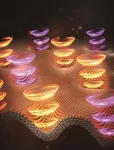(Press-News.org) “Eco-friendly” paper drinking straws contain long-lasting and potentially toxic chemicals, a new study has concluded.
In the first analysis of its kind in Europe, and only the second in the world, Belgian researchers tested 39 brands of straws for the group of synthetic chemicals known as poly- and perfluoroalkyl substances (PFAS).
PFAS were found in the majority of the straws tested and were most common in those made from paper and bamboo, the study, published in the peer-reviewed journal Food Additives and Contaminants, found.
PFAS are used to make everyday products, from outdoor clothing to non-stick pans, resistant to water, heat and stains. They are, however, potentially harmful to people, wildlife and the environment.
They break down very slowly over time and can persist over thousands of years in the environment, a property that has led to them being known as “forever chemicals.”
They have been associated with a number of health problems, including lower response to vaccines, lower birth weight, thyroid disease, increased cholesterol levels, liver damage, kidney cancer and testicular cancer.
“Straws made from plant-based materials, such as paper and bamboo, are often advertised as being more sustainable and eco-friendly than those made from plastic,” says researcher Dr Thimo Groffen, an environmental scientist at the University of Antwerp, who is involved in this study.
“However, the presence of PFAS in these straws means that’s not necessarily true.”
A growing number of countries, including the UK and Belgium, have banned sale of single-use plastic products, including drinking straws, and plant-based versions have become popular alternatives.
A recent study found PFAS in plant-based drinking straws in the US. Dr Groffen and colleagues wanted to find out if the same was true of those on sale in Belgium.
To explore this further, the research team purchased 39 different brands of drinking straw made from five materials – paper, bamboo, glass, stainless steel and plastic.
The straws, which were mainly obtained from shops, supermarkets and fast-food restaurants, then underwent two rounds of testing for PFAS.
The majority of the brands (27/39, 69%) contained PFAS, with 18 different PFAS detected in total.
The paper straws were most likely to contain PFAS, with the chemicals detected in 18/20 (90%) of the brands tested. PFAS were also detected in 4/5 (80%) brands of bamboo straw, 3/4 (75%) of the plastic straw brands and 2/5 (40%) brands of glass straw. They were not detected in any of the five types of steel straw tested.
The most commonly found PFAS, perfluorooctanoic acid (PFOA), has been banned globally since 2020.
Also detected were trifluoroacetic acid (TFA) and trifluoromethanesulfonic acid (TFMS), “ultra-short chain” PFAS which are highly water soluble and so might leach out of straws into drinks.
The PFAS concentrations were low and, bearing in mind that most people tend to only use straws occasionally, pose a limited risk to human health. However, PFAS can remain in the body for many years and concentrations can build up over time.
“Small amounts of PFAS, while not harmful in themselves, can add to the chemical load already present in the body,” says Dr Groffen.
It isn’t known whether the PFAS were added to the straws by the manufacturers for waterproofing or whether were the result of contamination. Potential sources of contamination include the soil the plant-based materials were grown in and the water used in the manufacturing process.
However, the presence of the chemicals in almost every brand of paper straw means it is likely that it was, in some cases, being used as a water-repellent coating, say the researchers.
The study’s other limitations include not looking at whether the PFAS would leach out of the straws into liquids.
Dr Groffen concludes: “The presence of PFAS in paper and bamboo straws shows they are not necessarily biodegradable.
“We did not detect any PFAS in stainless steel straws, so I would advise consumers to use this type of straw – or just avoid using straws at all.”
END
Paper drinking straws may be harmful and may not be better for the environment than plastic versions, researchers warn
Long-lasting “forever chemicals”, which can cause damaging health issues, found in 18/20 brands of paper straws
2023-08-25
ELSE PRESS RELEASES FROM THIS DATE:
Sediment movement during Hurricane Harvey could negatively impact future flooding, prove costly to Houston, UH study finds
2023-08-25
Enormous amounts of sediment, or sand and mud, flowed through Houston waterways during Hurricane Harvey in 2017, due in part to modifications made by humans to bayous, rivers and streams over the past century, that could seriously impact future flooding events and be costly to the City of Houston.
New analysis by geology researchers at the University of Houston found 27 million cubic meters of sediment, or 16 Astrodomes, moved through 12 Houston waterways and Addicks and Barker reservoirs during Harvey, the largest rainfall event in U.S. history. After the storm, up to five feet ...
USC-supported startup receives major grant for clinical trial of a promising eye treatment
2023-08-24
A stem cell patch developed by USC researchers for patients with macular degeneration will soon be tested in a phase 2b clinical trial.
This latest milestone in the patch’s development was made possible by a combined $21 million in support from a state organization, a nonprofit foundation and the university. Last month, the California Institute for Regenerative Medicine (CIRM) awarded an estimated $12.4 million to the USC-supported startup Regenerative Patch Technologies (RPT) to test the safety and efficacy ...
New detector paves the way to large-scale optical neural networks
2023-08-24
For the first time, researchers have used a surface normal nonlinear photodetector (SNPD) to improve the speed and energy efficiency of a diffractive optical neural network (ONN). The new device lays the groundwork for large-scale ONNs, which can perform high-speed processing at the speed of light in an extremely energy efficient manner.
Farshid Ashtiani from Nokia Bell Labs will present this research at Frontiers in Optics + Laser Science (FiO LS), which will be held 9 – 12 October 2023 at the Greater Tacoma Convention ...
The right combo: Getting the most health benefits from fruit smoothies
2023-08-24
Smoothies can be a tasty and convenient way to get the important fruits and vegetables you need for a healthy diet. But is a banana and blueberry smoothie the best combo? Researchers at the University of California, Davis, suggest that blending certain ingredients in smoothies can influence whether your body is getting a nutritional boost.
The study, published today in the Royal Society of Chemistry’s journal Food and Function, used smoothies to test how various levels of polyphenol oxidase, an enzyme in many fruits and vegetables, affects the levels of flavanols in food to be absorbed by the body. Flavanols ...
$12 million grant funds foundational research on early liver transplantation
2023-08-24
Alcohol-associated liver disease accounts for 50% of liver-related deaths, and its rates are rising worldwide. But one of the best treatment options, early liver transplantation (ELT)—transplants done with no mandatory period of abstinence from alcohol—is also one of the most controversial, partly because of concerns that patients will relapse to alcohol after transplantation.
Part of the problem is that livers for transplants are in short supply, and researchers lack data to determine who will benefit most from ELT. Studies show that decisions about who gets a transplant can, at times, be influenced by bias or unsystematic. ...
Study shows technology boosts public health programs
2023-08-24
An examination of the SCALE-UP Counts program was recently published in the journal Pediatrics. This analysis, led by Yelena Wu, PhD, investigator at Huntsman Cancer Institute and associate professor in the department of dermatology at the University of Utah (the U), and David Wetter, PhD, MS, investigator at Huntsman Cancer Institute and professor in the department of population health sciences at the U, received support from RADx-Underserved Populations (RADx-UP) and funding from the National Institute of Health (NIH).
The SCALE-UP Counts program was designed to promote COVID-19 testing through collaboration ...
A global observatory to monitor Earth's biodiversity
2023-08-24
At a time of nature crisis driven by unparalleled rates of biodiversity loss, a new interconnected system to monitor biodiversity around the world is urgently needed to direct and focus conservation action.
"The lethal combination of habitat loss, the exploitation of natural populations, pollution, and climate change is causing species extinction rates not seen since the last mass extinction 65 million years ago," said Prof. Andrew Gonzalez, Liber Ero Chair in Conservation Biology at McGill University, and co-Chair of GEO BON. "We lack the means to monitor these impacts ...
High drug price associated with decreased treatment retention for patients with chronic liver disease
2023-08-24
MINNEAPOLIS/ST. PAUL (08/24/2023) — Researchers from the University of Minnesota Medical School and College of Pharmacy have found that high costs for hepatic encephalopathy treatment in patients with end-stage liver disease were associated with decreased treatment retention for patients. The study results were recently published in Hepatology Communications.
Hepatic encephalopathy is the loss of brain function that occurs in people with severe liver disease. The condition is associated with high morbidity and mortality. ...
Optimizing tobacco cessation treatment with lung cancer screening
2023-08-24
MINNEAPOLIS/ST. PAUL (08/24/2023) —Lung cancer is the deadliest cancer in the United States, and 80% of lung cancer deaths are linked to one risk factor: smoking. While lung cancer screenings are a critical part of prevention and treatment for the disease and 15 million Americans qualify for yearly screenings, over half those eligible for screenings are still actively smoking. Without standard smoking cessation measures in place, the benefits of the screenings have not been fully realized.
New ...
New quantum device generates single photons and encodes information
2023-08-24
A new approach to quantum light emitters generates a stream of circularly polarized single photons, or particles of light, that may be useful for a range of quantum information and communication applications. A Los Alamos National Laboratory team stacked two different, atomically thin materials to realize this chiral quantum light source.
“Our research shows that it is possible for a monolayer semiconductor to emit circularly polarized light without the help of an external magnetic field,” ...
LAST 30 PRESS RELEASES:
Research validates laboratory model for studying high-grade serous ovarian cancer
SIR 2026 delivers transformative breakthroughs in minimally invasive medicine to improve patient care
Stem Cell Reports most downloaded papers of 2025 highlight the breadth and impact of stem cell research
Oxford-led study estimates NHS spends around 3% of its primary and secondary care budget on the health impacts of heat and cold in England
A researcher’s long quest leads to a smart composite breakthrough
Urban wild bees act as “microbial sensors” of city health.
New study finds where you live affects recovery after a hip fracture
Forecasting the impact of fully automated vehicle adoption on US road traffic injuries
Alcohol-related hospitalizations from 2016 to 2022
Semaglutide and hospitalizations in patients with obesity and established cardiovascular disease
Researchers ‘listen in’ to embryo-mother interactions during implantation using a culture system replicating the womb lining
How changing your diet could help save the world
How to make AI truly scalable and reliable for real-time traffic assignment?
Beyond fragmented markets: A new framework for efficient and stable ride-pooling
Can shape priors make road perception more reliable for autonomous driving?
AI tracks nearly 100 years of aging research, revealing key trends and gaps
Innovative techniques enable Italy’s first imaging of individual trapped atoms
KIER successfully develops Korea-made “calibration thermoelectric module” for measuring thermoelectric device performance
Diversifying US Midwest farming for stability and resilience
Emphasizing immigrants’ deservingness shifts attitudes
Japanese eels, climate change, and river temperature
Pusan National University researchers discover faster, smarter heat treatment for lightweight magnesium metals
China’s 2024 Gastroenterology Report: marked progress in endoscopy quality and disease management
Pusan National University researchers uncover scalable method for ultrahigh-resolution quantum dot displays
Researchers use robotics to find potential new antibiotic among hundreds of metal complexes
Gut bacteria changes at the earliest stages of inflammatory bowel disease
Scientists develop new way to “listen in” on the brain’s hidden language
Brain research: “Pulse generators” grow and shrink as memories are formed
For teens, any cannabis use may have impact on emotional health, academic performance
School meals could unlock major gains for human and planetary health
[Press-News.org] Paper drinking straws may be harmful and may not be better for the environment than plastic versions, researchers warnLong-lasting “forever chemicals”, which can cause damaging health issues, found in 18/20 brands of paper straws



